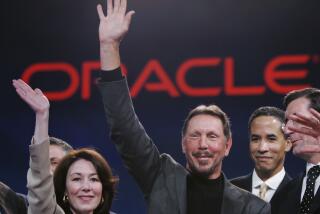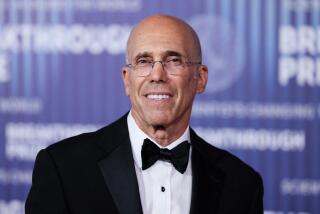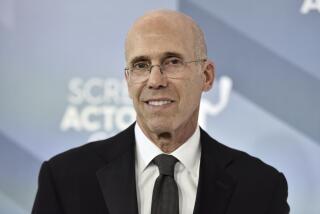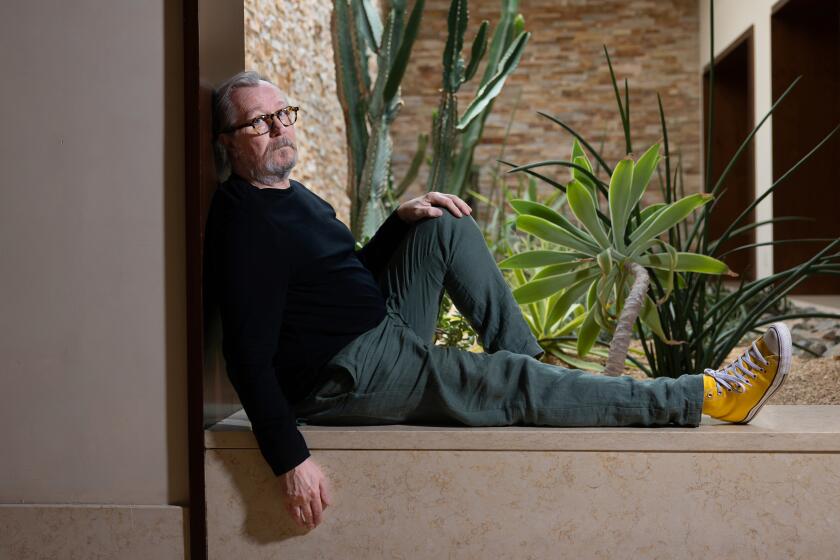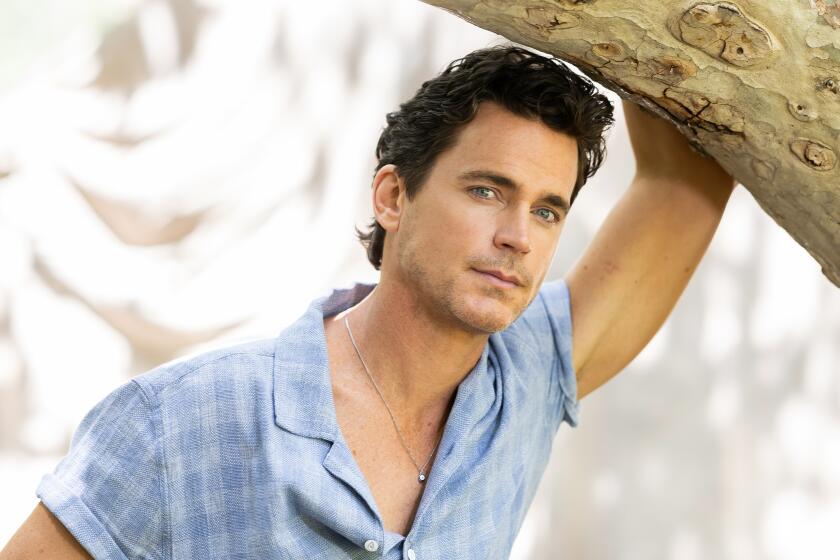If Katzenberg leaves, what’s to become of DreamWorks Animation?
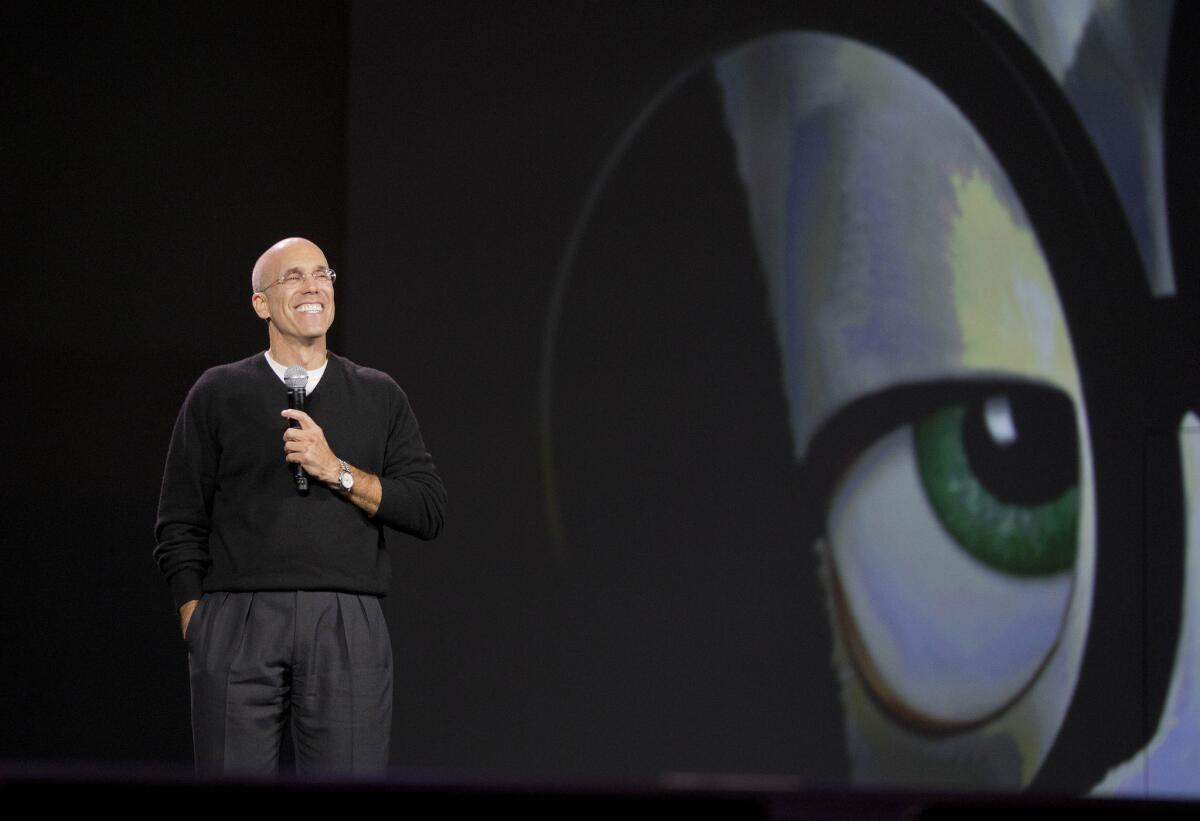
Few executives in Hollywood are as closely associated with their companies as Jeffrey Katzenberg is with DreamWorks Animation.
Katzenberg, 63, founded the company with Steven Spielberg and David Geffen in 1994 and oversaw construction of its Tuscan-style, 13-acre campus in Glendale. He also transformed the studio into a top producer of animated movies.
More recently, he has been leading efforts to diversify the studio by expanding into television and other new businesses to reduce its reliance on animated movies.
Now, with the company seen as a possible acquisition target by Japanese telecommunications giant SoftBank Corp., the question is what will be the future of the company without Katzenberg?
“He’s such a big personality, it’s hard to know what happens when he goes,” said Doug Creutz, a media analyst with Cowen & Co. “He has been the big creative vision and the strategic vision of the company.... I do think that is the question.”
DreamWorks shares Monday jumped 26% to $28.18 on this weekend’s news that SoftBank was considering buying DreamWorks for $3.4 billion. SoftBank and DreamWorks representatives declined to discuss the talks. One person familiar with the situation said prospects for a deal were not certain and that negotiations seemed to have quieted Monday.
If a sale to SoftBank goes through, any deal probably would include a five-year management contract for Katzenberg, according to the person familiar with the situation, who was not authorized to speak publicly.
Even if the SoftBank deal should collapse, however, Katzenberg has been laying the foundation for his eventual exit and a transition to new leadership.
The once famously micromanaging executive has handed over day-to-day management to others, ceding more authority to his top lieutenants, studio President Ann Daly and Chief Creative Officer Bill Damaschke.
Damaschke, a 50-year-old Chicago native, joined DreamWorks in 1995 as a production assistant before working his way up to become head of production for the studio. Daly, 58, is another DreamWorks veteran. A former executive at Disney Studios, where she worked with Katzenberg, Daly helped pioneer the home video industry. She joined DreamWorks in 1997, serving as chief operating officer and overseeing the company’s entries into TV and other ventures.
Last year, Katzenberg recruited Michael Francis, a former Target Corp. executive, to head the studio’s consumer products and branding efforts. He has also hired former Disney Studios executive Mark Zoradi to be chief operating officer, and brought Marjorie Cohn from Nickelodeon to run the studio’s television group.
Katzenberg has “definitely been the face of the studio, but I’ve got to imagine the studio can survive without him,” said Eric Wold, an analyst with B. Riley & Co. “They’ve got a great team there.”
Martin Kaplan, who worked with Katzenberg at Walt Disney Co. years ago, said Katzenberg appears to have put a succession team in place.
“He has put together a cadre of administrators, artists and storytellers which has great bench strength,” said Kaplan, who is now a professor at the USC Annenberg School for Communication and Journalism. “It’s as close to a turnkey operation as you could get.”
A former executive at Paramount, Katzenberg was part of the team led by Michael Eisner and Frank Wells that turned around a struggling Disney in the 1980s and 1990s.
With his famous work ethic, the brash young executive led the revival of Disney’s once vaunted animation unit with such as hits as “The Lion King” and “The Little Mermaid.”
But after a highly publicized clash with Eisner, Katzenberg left Disney to launch his own studio with Spielberg and Geffen.
Although DreamWorks never achieved its goals of creating a broad-based studio, the animation division, which was spun off into a separate company in 2004, became an archrival to Disney.
Luring many former colleagues from his former employer, Katzenberg single-handedly built the studio into a industry powerhouse, achieving success with the “Shrek,” “Kung Fu Panda” and “Madagascar” movies.
In recent years, however, Katzenberg has faced growing questions from investors as the studio has struggled to replicate the success of its earlier films. The company has had three write-downs in two years for “Turbo,” “Rise of the Guardians” and “Mr. Peabody & Sherman.”
DreamWorks has had to contend with a growing number of rivals as others have muscled in on the lucrative animation business. Universal Pictures and Warner Bros. have scored some surprise box-office hits with the “Despicable Me” films and “The Lego Movie.” And DreamWorks’ next-door neighbor, Walt Disney Studios, is on a roll in the wake of “Frozen,” the highest-grossing animated movie of all time.
“We have been inconsistent,” Katzenberg acknowledged in an interview this year. “The only thing I can guarantee you is we are our harshest critics.”
What would Katzenberg do after DreamWorks? He would certainly have plenty of options.
Katzenberg is active in philanthropy circles and is one of the people Democrats court when they come to Hollywood to raise money. He is one of the top contributors to the Democratic Party and has the ability to put the arm on friends and colleagues when it’s time to raise campaign cash. He organized a prominent Hollywood fundraiser for President Obama at the home of George Clooney during the 2012 presidential campaign.
“For a person who can move a million miles a minute, it’s a little hard to imagine him sitting on a veranda sipping something with an umbrella in it,” Kaplan said.
Follow me Twitter: @rverrier
Times staff writer Saba Hamedy contributed to this report.
More to Read
From the Oscars to the Emmys.
Get the Envelope newsletter for exclusive awards season coverage, behind-the-scenes stories from the Envelope podcast and columnist Glenn Whipp’s must-read analysis.
You may occasionally receive promotional content from the Los Angeles Times.
